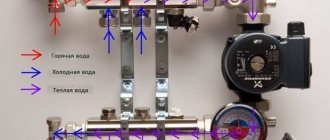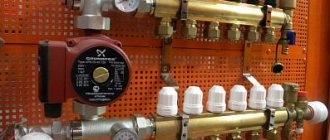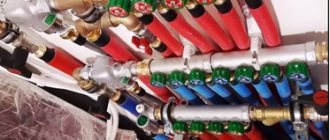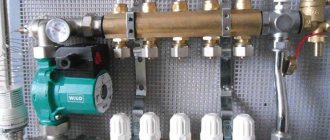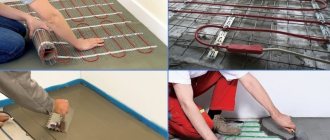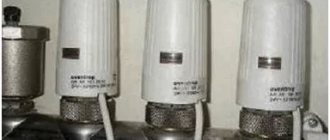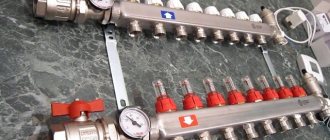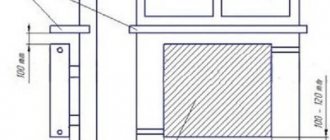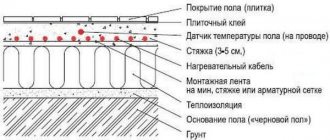Water heated floors are a little more difficult to regulate than their electric counterparts. Regulatory functions are performed by two important devices - a mixing unit for heated floors and a collector that uniformly supplies water to all circuits of the system.
Using them, you can obtain the optimal temperature of the coolant, as well as its quantity, i.e. make the heating equipment operate as efficiently as possible. But how to properly install this important unit? We'll talk about this in our article.
Let us consider in detail the features of installing a water heated floor in a high-rise building, and along the way we will analyze the device and the main functions assigned to the mixing unit.
We supplemented the article material with colorful photos and thematic videos on the assembly of the collector and the intricacies of installing a mixing unit for a water-heated floor.
Connection via three-way valve
A slightly different assembly and operating principle is the option of connecting a heated floor through a three-way valve, which is shown with an arrow in the diagram below.
This scheme is used in cases where, in addition to a heated floor, the system also contains a main heating circuit. The temperatures of the coolant in them will be different, which is why a mixing valve is needed.
Connection via three-way valve
- This device not only regulates the water supply to the circuit (it is mounted on the supply pipe in front of the circulation pump), but also at the same time, using a built-in thermostat, controls its temperature, mixing cold coolant with hot one. In this case, the pressure in the pipeline corresponds to the pressure set on the pump.
- However, the valve cannot accurately dose the amount of water for mixing, so the temperature in the floor circuit may be either underheated or too hot. The problem is solved by connecting a servo drive to it, since it is this that balances the operation of the system and protects the floors from overheating.
Three-way mixing valve
The circuit with a mixing valve is quite accessible for self-installation, and the equipment for it does not require large expenses.
Restrictions and regulations
Let's start with the fact that water heated floors do not belong to high-temperature heating systems. According to the standards, the coolant temperature cannot be exceeded or heated above 55C.
In practice, heating occurs to a maximum of 35 or 45 degrees.
However, do not confuse the temperature of the coolant and the temperature of the floor surface. It can range from 26 to 31 degrees maximum.
- where you are constantly (living room, bedroom, kitchen) - it’s 26C
- in rooms with temporary stay (bathroom, separate hallway, loggia) - 31C
Also, don't forget about the circulation pump. A warm floor is still a separate independent circuit. The pump can be either built into the boiler or mounted outside it.
With the help of a pump, it is easier to fulfill another requirement regarding temperature differences. For example, between supply and return, the difference should be no more than 10 degrees.
But when choosing a pump, do not overdo it with the flow rate of the coolant. The maximum permissible value here is 0.6 m/s.
Knowing all these limitations and recommendations, let's move on directly to the schemes themselves.
Diagram with two-way valve
Install it on the supply from the heating device. A balancing adjustable valve is installed in the place of the jumper between the supply pipeline and the return line. It is adjusted in accordance with the required temperature of the supplied water, usually using a hex key. It is needed to regulate the amount of cold coolant.
The temperature sensor is placed after the pump, which in turn moves water in the direction of the comb. Only now the intensity of movement of the heated coolant from the boiler changes. In this way, the temperature of the supply water changes at the pump inlet, while the cold flow is adjusted and stable.
Mixing always occurs and water from the boiler does not enter directly into the circuits, since this is impossible. This scheme can be considered more reliable. But it should be noted that a mixing group equipped with a two-way element is capable of heating 150 - 200 “squares” of area, since there are no valves with greater capacity.
Manifold for underfloor heating system
For heated floors, a common collector unit is most often installed, or a separate collector is installed in front of each heating circuit. If the latter option is implemented, then all collectors are equipped with flow meters, thermostats, as well as the following elements:
- Return and supply mixing valve;
- Shut-off valve for balancing the heating device;
- Overflow valve.
You can assemble a collector for a heated floor yourself using different schemes, and in some schemes of collector units bypasses are used, but not always - only in single-circuit systems. If the underfloor heating system is organized according to a dual-circuit scheme, then the collector can be connected without a bypass to the secondary circuit.
Double-circuit underfloor heating system with collector
Before assembling a manifold assembly for a heated floor, weigh your options - sometimes it’s easier to buy a ready-made structure. If you are going to buy a collector, it is better that all its parts and elements are from the same manufacturer. When assembling the unit yourself, you must select the material from which the main components of the unit will be assembled: copper, steel, polymers or brass.
Also, when choosing an industrial design, it is important to consider the following parameters:
- How many heating circuits will there be in the system (usually from 2 to 12), the total length of the pipeline and the capacity of the circuits;
- Maximum permissible pressure in pipes;
- Possibility of expanding the heating system;
- Manual or automatic collector control;
- Electrical power of all components and assemblies;
- The diameter of the internal holes of the collector (throughput).
Do-it-yourself collector
The most efficient operation of the assembled collector units can be ensured by connecting heating circuits of equal length to them. In order to equalize the length of the pipelines with sufficient accuracy, they are divided into equal sections, which are connected to the collector. The easiest way is to calculate the collector unit in a special computer program or on an online calculator, so that the phenomenon called “thermal zebra” does not appear, that is, uneven heating of the floor.
For the calculation you will need the following data:
- Type of decorative flooring;
- the area of the heated room and the plan for placing large objects in it;
- Material and diameter of circuit pipes;
- Boiler rated power;
- Type of floor insulation.
Reservoir calculation
Collector installation - recommendations
When designing a heated floor system, you first need to find the optimal location for installing the collector. Typically, the unit is installed in a manifold cabinet, and the cabinet itself is mounted at a height of 30-40 cm from the floor level next to the supply and return.
In order not to blame your own mistakes and ensure maximum heating of the heated floor pipes, study the instructions for connecting the collector. Then assemble the unit in the following sequence (this applies to an industrial manifold unit):
- Unpack the tubes for forward and reverse coolant supply. The tubes must have flow meters and supply valves. If the collector is multi-sectional, assemble the sections into one structure;
- From the assembled sections you need to assemble a unit on brackets (included in the kit);
- Next, we install shut-off valves, automation, sensors and other connecting fittings;
- We attach the unit to the wall or in a cabinet, install a thermostat, a servo drive and a circulation pump;
- We connect the pipes from the boiler and the pipes from the heating circuits of the “warm floor” system.
Manifold set
Now the connection diagram for the heated floor collector is pressed, after which the concrete screed can be poured. Thermal adjustments of the collector can be carried out after installation of the finishing coating.
DIY collector unit
A factory manifold is a fairly expensive product, so many craftsmen want to make it themselves. You will still have to buy many elements, but the cost will be cheaper. The easiest way is to solder a homemade manifold from PVC pipes and fittings Ø 25-32 mm. You will also need tees and bends of the same diameters, and shut-off valves.
Homemade collector
The number of valves and fittings is calculated by the number of heating circuits. The tools you need are a soldering iron for propylene elements and attachments for it, special scissors for cutting pipes and a tape measure.
Marking the collector consists of marking and cutting pipes of the required length, observing the minimum distance between the tees. Valves and transitions are soldered to the PVC tees with a soldering iron. Fittings for connecting the pump are soldered to this structure. As you can see, everything is simple, but it is better to buy more complex collector units ready-made.
How to choose
Installing a heated floor, even in a private house, is a rather complex engineering system with ambiguous results. If the adjustment is poor, all the benefits may disappear, so you cannot save on the manifold assembly and control valves. Good three-way valves are not cheap, and there is a high probability of purchasing low-quality products on the market or on the Internet.
For a heated floor system, it is better to buy equipment in a hypermarket or specialty store. A certificate is a must! Or a passport with a “wet” stamp and a completed guarantee. The receipt must be kept.
Usually they buy products made of brass. Stainless steel valves are more expensive and less commonly sold. Silumin is not even worth considering - products made from it do not tolerate constant opening and closing, and the control valves cost a lot.
When purchasing in a store, you need to inspect the valve to ensure there are no chips, cracks, or jams. You need to try to look inside the valve - on brass products without coating, the inside should be golden (and not white-silver, like silumin). You can navigate by weight. Silumin products weigh much less than brass ones - the density of brass is approximately three times greater than that of silumin.
Popular manufacturers
In first place in terms of quality are the products of the Swedish company ESBE. The company has been producing pipe fittings for various purposes for over a hundred years. The second place is occupied by the American company Honeywell. Fittings from HEIMEIER, HERZ, Navien, Danfoss, Mut, Oventrop, Siemens are common. The cost of these products outstrips the quality. The products of the joint Italian-Russian manufacturer Valtec have a more reasonable price.
approximate price
The table above is the prices for a Three-way valve with a thermal head. To find out how much equipment costs in your region, it is better to contact the nearest construction hypermarket. Approximate prices for a three-way valve with electric drive:
Controlling the operation of a heated floor system
The efficiency of heating devices depends not only on their power and adjustments, but, above all, on the condition of the heated object. If a building is not insulated enough, no system will create conditions for comfortable living in it. Walls made of porous materials such as sawn shell rock or foam concrete reduce heat loss by 20 - 25% compared to ceramic bricks; additional wall insulation and wind protection, as well as insulation of the roofing pie, give approximately the same effect.
Turning to the issue of controlling the operating mode of heated floors, it should be noted that two main approaches are used: manual control of the mixing unit and the use of automatic control systems.
The first option is used for small buildings consisting of 2 or 3 living rooms and auxiliary premises. Setting the mixing mode is done manually using an ordinary tap.
For complex, developed heating networks, this method is unrealistic due to the multifactor nature of the process and complex automated devices are used.
Heating control systems can be:
- group - their task is to convert the water temperature at the outlet of the boiler of 75 - 90 degrees into the 35 - 40 degrees required for low-temperature circuits at the inlet and control the temperature of the return flow, making adjustments to the mixing mode. Naturally, changes in weather conditions also affect the amount of heat transfer in the heating system;
- individual - the coolant flow rate for each circuit is set so that the room has a constant temperature within a given range. This is achieved either by installing a temperature sensor in the room or by monitoring the return flow temperature at the outlet of the register directly at the collector unit.
Equipment
It is impossible to display the entire variety of devices in a short article, so we will focus on some of their typical representatives:
Group controllers
Heating is controlled by applying a pulse to the servo drive of the control valve, which performs the corresponding manipulation. Up to 10 channels from sensors are installed in one controller to adjust the mixture in various circuits. Programming is possible.
Heated floor operating mode control unit
When an external temperature sensor is connected, the coolant heating temperature mode changes preventively.
Thermostats
A remote device capable of measuring temperature at the installation site and transmitting data about it to the heating system control unit. The device can transmit information both over wires and over a radio channel. It should be installed in a place protected from sunlight and away from drafts.
Room thermostat for water floor
A device for directly controlling the temperature of the coolant flow. Placed in a pipeline rupture. Usually equipped with a servomotor to control the damper. It is calculated at work at a system pressure of up to 16 atmospheres.
Three-way thermostatic valve in a heated floor control system
Servo
A device that actuates a valve's shut-off device (stem). The small-sized device creates a force of more than 10 kg.
Servomotor for underfloor heating valve
Advantages and disadvantages
Three-way thermostatic mixing valves are simple in design, yet reliable and durable. Their use allows for high-quality and precise control of the floor heating level.
Thermostatic valve for heated floors: types and their design, how to choose, installation diagrams and alternative connection methods
The devices are sealed and compact. Plus - they do not allow the pipes and screed to overheat, which extends the life of the system.
The benefits of control valves are irrefutable, but they have a number of disadvantages:
- They increase hydraulic resistance - this negatively affects the functioning of a unit that has more than one collector.
- There is a risk of a large volume of hot coolant entering the floor pipes. And this can lead to leakage and airing of the system. Such problems most often occur when the device is starting up.
Direct connection diagram
You have a boiler, after which all safety fittings + a circulation pump are installed. In some wall-mounted boiler versions, the pump is initially built into its body.
For floor-standing units you will have to install it separately. From this boiler, the water is first directed to the distribution manifold, and then disperses through the loops. After which, having completed the passage, it returns through the return line to the heat generator.
With this scheme, the boiler is directly adjusted to the desired temperature of the TPs themselves. You don't have any additional radiators or radiators here.
What are the main features worth paying attention to here? Firstly, with such a direct connection, it is advisable to install a condensing boiler. In such schemes, operation at relatively low temperatures for the condenser is quite optimal
In this mode it will achieve its highest efficiency
In such schemes, operation at relatively low temperatures is quite optimal for the condenser. In this mode it will achieve its highest efficiency.
If you use a regular gas boiler, you will soon say goodbye to your heat exchanger.
The second nuance concerns solid fuel boilers. When you have it installed, for direct connection to heated floors, you will also need a buffer tank.
It is needed to limit the temperature. It is very difficult to directly regulate the temperature with solid fuel boilers.
How to properly assemble and connect the collector
Install the frame - the collector is mounted in a horizontal position directly on the wall, or in a cut-out niche. The only condition for installation is free access to the heating pipe arrow. It is also possible to install a manifold cabinet yourself
The cabinet will allow you to hide the wiring from prying eyes, which is especially important if a bathroom or hallway is used as a boiler room.
Connection to the boiler - coolant supply is from below, return is from above. Ball cut-offs must be installed in front of the frame.
A pump group is installed immediately behind the taps. To maintain the required temperature, the heated coolant is only partially used. The pump not only creates the necessary pressure in the heating system, but also helps to mix cooled water from the floor circuit and heated water coming from the boiler. A bypass valve with a temperature limiter is installed. A distribution comb is installed behind the valve. The distribution of the collector to heated floors is carried out as follows. The pipes going to the heated floor are attached from above, from the heating system from below. If you need to assemble a distribution manifold for a warm water floor with your own hands, shut-off valves with a built-in thermostat are installed in the comb. Practice shows that the best option is to purchase a ready-made structure. Assembling a manifold, even by a professional, and adjusting the valves independently is a labor-intensive process that requires certain skills and experience. Connecting a warm water floor collector requires the use of special components. Compression fittings are used, consisting of a support sleeve, a clamping ring and an intermediate brass nut. After installation, the collector is configured.
Pressure testing of the collector - after completing the installation work, it is necessary to check the sealing of the connections. To do this, the completed collector group is connected to a pump (pressure tester). Using a pressure tester, pressurize the system. The water circuit is left under pressure for a day. If the pressure readings have not changed, it means that the installation of the heated floor manifold with your own hands was done correctly and the mixing unit is ready for operation.
At first glance, installing the collector yourself seems quite simple. But as practice shows, it is better not to start installation without the necessary tools and special skills.
Self-assembly
Assembly diagram
You can assemble the collector yourself. As a rule, the manufacturer includes a detailed wiring diagram in the kit. The following types of work will be required:
- The equipment is fixed in a horizontal position on the wall or in a niche. The main requirement is to provide access for servicing and managing node elements. If the collector is not installed in a separate room, but in a bathroom or hallway, it must be disguised for aesthetic purposes by installing it inside the collector cabinet.
- Heated water from the boiler is supplied from below, and a “return” is mounted on top. To install shut-off valves, select an area in front of the frame, and install the pump after them. With its help, the “return” and hot water will be mixed, and the optimal pressure in the pipes will be maintained.
- Install the bypass valve and distribution comb.
- After this, it is necessary to install the pipes. Those that go to the floor are fixed at the top, and the pipes from the heating system are fixed at the bottom.
- When connecting the manifold, components are used in the form of compression fittings, which include a support sleeve, a clamping ring and an intermediate brass nut.
- When the installation work is completed, they begin to check the tightness of the connections - pressure testing. To do this, use a special pump to increase the pressure in the system and leave it for 24 hours. The collector unit is completely ready for operation if the initially set pressure value has not changed during the day.
If you lack experience when assembling the collector yourself, the following mistakes may be made:
- Incorrect bypass setting due to incorrect calculations of the permissible load on the circuit. Such calculations must be performed before installation work begins.
- The absence of a separator leads to the formation of air pockets in the water kennels, which reduces the efficiency of the heating system.
- Wrong choice of hot water supply point. The coolant should come from above, not from below.
- Lack of a check valve, which will be needed to prevent leakage.
If the collector was initially assembled incorrectly, it will be problematic to subsequently eliminate errors and remake the system. Therefore, it is better to entrust the work to a specialist who will properly assemble and configure the equipment.
Is a collector necessary?
The main disadvantage of the device is its high cost, but it must be taken into account that without it, warm water-type coatings will not be able to function normally. This is only possible if the covering consists of one heating circuit. In modern heated floors, the length of pipes for installation cannot exceed 70 meters. Since this amount will only be enough for 7 square meters of area, for a medium-sized room you will need at least three circuits.
Most often, warm water-type coverings are installed in all rooms of an apartment or house. In this case, it will be necessary to install a collector to uniformly distribute the coolant supply. If we are talking about one small room, you don’t need to purchase a collector. It must be remembered that without this device the coolant will be supplied at the same temperature as in a general heating system. Also, without it it is impossible to remove air pockets and control pressure.
Application area
Underfloor heating systems are increasingly popular in residential buildings today, but without a control valve it is impossible to ensure proper heating. A three-way tap is an element designed to adjust the heating level in a water floor that is filled with screed.
The valve is installed both as a complete set with a mixing and distribution unit, and as an independent device. In small rooms (bathtub, toilet, kitchen), there is no point in installing a multifunctional collector - it is expensive and not justified.
A three-way thermomixing valve can control the temperature and regulate the volume of liquid for such rooms.
Main areas of use:
- In a radiator heating system.
- In the DHW system.
- In warm floors.
Manifold connection to the boiler
The process of connecting a warm water floor with a comb is very simple and boils down to connecting the pipes of the heating circuits to the collector, and the collector itself to the boiler. However, there are differences in the configuration of the collector. This is what we will consider in this subsection.
The collector must be installed in such a way that it is convenient to connect the heating circuit pipes to it. So, install shut-off valves on the collector. Connect the side outlet to the pipe for both supply and return.
If you buy a ready-made manifold kit, it will already have all the necessary valves, even at the outlets of the pipes going to the boiler. The presence of taps will allow you, if necessary, to carry out repairs or temporarily disconnect one of the circuits. If you assemble the manifold yourself, then the connection of each element is assembled using a compression fitting. As a result, the heated floors will be connected to the boiler through the manifold.
To automate coolant temperature control, the following set of equipment is additionally installed in the collector:
- Pumping and mixing unit, which includes a three-way mixing valve.
- For forced circulation pump.
- Drain tap.
- Air vent.
So, instead of shut-off valves, install thermostatic control valves on the manifold. Their design contains a thermal cylinder with paraffin, which, based on the air temperature in the room, narrows or expands. These actions set the capacity of the thermostatic valve. As for the pumping and mixing unit, the principle of its operation was written above.
So, we have looked at the basic and working diagrams for connecting a warm water floor. As you can see, knowing how to properly install a water floor is not enough. It must be connected correctly. We hope that this article will help you understand the intricacies of this work. And if you already have personal experience, then leave reviews and comments at the end of this article regarding the water heated floor connection diagrams you use.
Expert advice
Before choosing control equipment, you need to decide what area needs to be heated. If you will be heating a bathroom, part of the floor of a bedroom or a children's room, there is no need to purchase fittings with a thermal head - it is easier to use a manually operated three-way valve than to install a full-fledged expensive mixing unit.
The cost of a mixing and distribution unit with shut-off and control valves, a manifold, a pressure gauge, and a Mayevsky tap exceeds the cost of all pipelines (if they are made of polymer and not expensive copper).
If the underfloor heating system includes several rooms, then it is necessary to order a project from a qualified plumbing engineer before installation - it will indicate the characteristics of the valve. If there is a large area of heated floors and a large number of rooms, one or more mixing units will be needed.
The connection diagram of each unit includes a manifold - a distribution comb, to which heating pipelines are connected. A three-way mixing valve and pump are installed in front of the manifold. The valve can be with a thermal head or with sensors, a controller and an electric drive.
System elements
System elements
All schemes are united by ease of operation, the possibility of self-assembly, as well as the location of the main elements. The supply and return are located on the left side, and the manifold with combs is on the right. The differences between the schemes lie in the addition of some details. More often, the collector is located near the mixing unit, less often - at a distance, which may be due to a lack of free space or the planning features of the room.
The composition of the components depends on the material of the pipes used - cross-linked polypropylene, metal-plastic, corrugated stainless steel or copper.
The following elements are used in the scheme:
- Shut-off valves in the form of ball valves. They do not participate in the regulation of the main indicators of the coolant - its temperature and pressure, but are necessary during repair work when it is necessary to turn off individual components of the system.
- An oblique filter designed for mechanical water purification. It is used in the system if there is no confidence in the purity of the water used. Such a filter will not allow solid particles to enter the tuning device, thereby ensuring correct operation of the system and extending the life of the valves.
- Thermometers that provide visual control over the temperature of the water inside the circuit. Some models are equipped with a probe that is in direct contact with the coolant. Thermometers are liquid, mechanical and digital.
- The thermostatic valve is the main control element of the mixing unit. A thermostatic head is placed on top of it. When the temperature of the coolant changes, the head mechanically acts on the thermal valve. If the temperature is exceeded, the valve closes, and when the temperature drops, it opens.
- A bypass for cold water selection is a jumper that is formed between the supply and return pipes using plumbing tees. To fine-tune the coolant pressure, a balancing valve is installed on the bypass, which will ensure optimal operation of the system and its quietness.
- The optimal speed of water movement through the pipes is ensured using a circulation pump.
Supply choke
The two-way valve system is the simplest to implement. Control of the temperature of the water entering the pipes of the system is carried out thanks to a thermostatic head mounted on the valve and a liquid sensor. The opening and closing of the valve occurs thanks to the head, which passes hot water from the boiler into the circuit or cuts it off.
Thus, water from the “return” flows unlimitedly, and hot water only when necessary under the control of the valve. This prevents overheating of the heated floor and extends its service life. The low capacity of the two-way valve ensures smooth regulation of water temperature, eliminating sudden changes.
Three way throttle
Unlike a two-way valve, a three-way valve mixes water of different temperatures inside itself. This element combines a supply bypass valve and a bypass. The peculiarity is the ability to adjust the amount of hot and cold coolant for mixing, thanks to the damper located between the hot water pipe and the “return”.
Such valves have disadvantages. There is a possibility of supplying very hot water based on a signal from a temperature sensor, which, due to a sharp drop, can provoke an increase in pressure in the pipes and a violation of the integrity of the circuits. The large capacity of a three-way valve can cause a sharp drop in water temperature in the circuit even with a minimal adjustment of the device.
Construction of a pumping and mixing unit
Each manufacturer offers its own design solutions for mixers for heated floors. However, ready-made components, especially imported ones, are quite expensive, whereas such a device can be assembled independently from individual elements. We will describe below how to make such a budget option, using the option with a three-way valve as a basis.
Elements for assembly
Purchase all the components needed to assemble the unit.
What is required to assemble a mixing unit
Main details for a circuit in a room of 20 square meters:
- circulation pump power 15/4;
- two temperature-controlled collectors;
- mixing valve;
- two check valves;
- fittings with a union nut (usually 16x2);
- couplings with transition to outer and inner radius;
- sanitary flax for sealing joints;
- Unipak silicone sealant.
Warm floor collector
The dimensions of the connecting fittings are selected in accordance with the capacity of the system and the diameter of the pipeline.
Table. Step-by-step assembly instructions.
| Steps, photo | Description of actions |
| Step 1 | There is an arrow on the mixing valve that shows the direction of flow of the coolant. On the side where it is red, there should be a hot water pipe inlet. |
| Step 2 | Below is the return entrance. |
| Step 3 | Take the adapter, separate a small strand of flax and wind it dry onto the thread. The shape of the winding does not matter; it is not necessary to follow the thread pitch. |
| Step 4 | Then squeeze a little sealant over the flax and spread it with your finger along the entire circumference of the thread. Try to do this carefully so that the sealant does not get inside the coupling. |
| Step 5 | Screw the adapter to the mixing valve on the side where the water for the floor contour will come out. |
| Step 6 | To tighten the connection, you can use pliers inserted inside the sleeve. The excess sealant squeezed out should be removed with a napkin. |
| Step 7 | Similarly, on the opposite side (from where the hot water will enter), a check valve is connected to the mixing tee using an adapter with a double-sided thread. Tighten the connection well with an adjustable wrench and wipe dry again. |
| Step 8 | After the sleeve is tightened well, screw the valve itself. It is very important to place it correctly. Follow the arrow on the body, which shows the direction of water movement. |
| Step 9 | The check valve will be located at the bottom of the mixer - where the cooled water from the return pipeline will enter it. |
| Step 10 | A tee with a valve is connected to the check valve, through which the manifold will communicate with the mixer. |
| Step 11 | The mixing unit itself is already assembled. Now you need to attach the rest to it. First, pump, after installing a rubber gasket on the connection. |
| Step 12 | The pump will be located on the left, at the outlet of the mixer. |
| Step 13 | The manifold is connected to the tee from below through a corner adapter. |
| Step 14 | A fitting is screwed onto the pump outlet. In this case it is polypropylene, but it can be any other. The main thing is to make a quality connection. |
| Step 15 | In order to later be able to fix the unit on the wall and provide the collector with an indentation for the return pipe to pass under it, use a plumbing clamp. Usually it is attached to a pin, but in this case the master cut 2 cm from the propylene pipe to use it as a stand. |
| Step 16 | The clamp nut fits perfectly into the hole in the tube. |
| Step 17 | Install the clamps. In this case, there will be three of them: under the return manifold, under the polypropylene fitting to the left of the pump and to the right, under the valve at the hot water inlet. |
| Step 18 | When you buy a complete unit from the manufacturer, the kit includes a special screen on which it is installed. Since we are assembling it ourselves, we can use a piece of OSB sheet cut to the required size as a screen. Place the assembled assembly on it, place clamps with stands in the right places and outline their contours so that you can see where to make the fastenings. |
| Step 19 | Now the collector needs to be removed and the clamps secured to the panel. |
| Step 20 | To do this, you need to drill thin holes in them in the center and screw them to the plate with self-tapping screws. |
| Step 21 | When the mixing unit is installed in its original place and secured with clamps, all that remains is to attach the heated floor manifold to it from the pump side. Note! In this case, the master assembles this part of the structure from polypropylene, but since you probably do not have a special soldering iron for it, you can use connecting fittings made of brass. |
What does the assembled mixing unit look like?
In the end, the hand-assembled mixing assembly will look like the one shown in the photo, and we really hope that everything worked out for you.
Prices for a manifold for heated floors
manifold for underfloor heating
Mixing valves
Depending on the desired effect, there are various connection methods. Each of them necessarily involves the installation of mixing valves. These devices are necessary to connect hot and cold water. The latter is supplied from the heating circuit, the former from the boiler. The system can be adjusted automatically or manually, which requires additional installation of a control servo drive. There are two types of mixing valves.
Two way servo
This servo is also called the feed servo. Its main difference from conventional valves is the ability to conduct water in only one direction. If the valve is reinstalled incorrectly, it begins to malfunction and quickly fails.
“Feeding” – conducts water in one direction only
A ball or a special rod is used as a locking part for it. Adjustment is made either by turning the ball or moving the rod. Electric drives are used to carry out these manipulations.
The most popular method is a thermostatic head equipped with a water sensor that regularly monitors the temperature of the coolant. Taking into account the received data, the head turns the valve on or off. So, coolant is supplied from the return line regularly, and from the boiler - only as needed.
The operating principle of the device explains the main advantage of the manifold, which is equipped with a supply valve. Floors with this equipment do not overheat, this significantly increases their service life. The low throughput of the valve creates a smooth adjustment of the coolant temperature; significant jumps in this case are excluded.
Supply valves are characterized by ease of installation and subsequent operation. They are quite often found in the circuit of homemade manifolds for heated floors, but they have some limitations in application. It is not recommended to install two-way devices in systems that operate in rooms larger than 250 square meters.
Three-way systems
Three-way elements are designed differently. This equipment combines the operation of a bypass supply valve and a bypass valve. The valve consists of a body with one supply and two outlets. For regulation, either a rotating ball or a special rod is used.
The peculiarity of this type of device is that the adjusting part completely blocks the flow and distributes the incoming water, mixing it. The temperature is adjusted automatically; for this, the valve has a drive system that receives signals from various sensors.
Such valves have servo drives
Typically, three-way valves are equipped with actuators that are controlled by thermostatic sensors or weather-compensated controllers. The servo drive activates the locking mechanism, which is installed in the required position to obtain the required indicator of the heated coolant and return.
Weather-dependent controllers are required to regulate system power based on the weather. For example, during a cold snap, the room will begin to cool down much faster, meaning it will be much more difficult for the heating system to do its job.
To make the task easier, you need to increase the consumption of coolant and increase the temperature. The main disadvantages of three-way elements include significant throughput. Under these conditions, even a slight shift in adjustment can lead to a sharp change in water temperature.
Three-way elements are used for manifolds installed in rooms larger than 250 square meters. m and systems with a large number of circuits. Moreover, they are used for structures that are equipped with weather-sensitive sensors that determine the required floor temperature taking into account atmospheric conditions.
Manufacturing materials
Three-way thermomixing valves are made from the following materials:
- Brass is a copper alloy with zinc additives. The product is not subject to corrosive destruction, it is strong and durable. Sometimes these thermomixers have a chrome or nickel coating, which protects against darkening. This option is most often used in residential areas.
- Bronze is a copper alloy with tin additives. It is rare, although the quality is no worse than brass.
- Stainless steel is an excellent metal for making control products. It is characterized by durability, strength, and corrosion resistance. But the cost of appliances made from it is high, so they are not suitable for a private home.
There are titanium and carbon steel regulators, but they are recommended for industrial use. Valves are produced from silumin (an alloy of aluminum and silicon), their disadvantage is low strength.
Device installation
The manifold for a warm water floor is mounted according to the following scheme:
- It is necessary to install a frame under the device. It is mounted directly on the wall in a horizontal position or in a specially prepared niche. When choosing a location for installation, you should be guided by the availability of free access to the device to connect the required number of pipelines. Also, a special cabinet is often used to mount the device. In this form, the device can fit into any room.
- Connection to the heating boiler. The coolant is supplied to the system from below, and the return is placed at the top. You also need to install cut-off balls in front of the frame. A circulation pump is installed behind the taps.
- The bypass valve is being installed. It must be equipped with a temperature limiter. Behind this unit the distribution comb is installed.
- Pipelines are being laid to the heated floor. The elements through which coolant will flow into the system are placed on top. Pipelines from underfloor heating are installed from below.
- If you intend to install the device yourself, you must connect shut-off valves that are equipped with a thermostat to the distribution comb. When installing a ready-made kit, this is not necessary.
- The collector is connected to the heating system using compression fittings. This element consists of a clamping ring, a support sleeve and an intermediate nut.
- Pressure testing of the collector. After installing all structural elements, it is necessary to check how tight the resulting system is. To do this, the unit is connected to a circulation pump. With its help, pressure is built up in the system. The water circuit is left in this form for a day. After this time, the pressure is checked. If it has not changed, then the installation was successful.
Separate requirements for gas equipment parameters
Heating using natural resources will have to be chosen correctly. Only in this case it is possible to avoid unnecessary negative emotions, waste of time, and loss of money.
All requirements are established by state standards. Their meaning is strict and unchanging. Linking directly to the area is due to technical capabilities. Which:
- 60 kW. Suitable for 2 meter ceilings. The room has 8 cubic meters of air volume;
- The boiler room is ventilated through three air exchanges. Combustion takes oxygen from a separate source. Kitchen window with window. The air flow is stable in both cases;
- There is a protective layer between the fasteners and the equipment itself. This is usually a sheet of metal. Its role is to prevent fire when the temperature rises during operation;
- the distance to the wall is at least 3 cm. The front side of the boiler allows it to be serviced on one square meter. From the sides, the distance from the unit is at least 60 cm;
- horizontal supply to the chimney no more than 3 meters. The diameter of the pipes used is the same as the heater. It's even better to connect a larger value. Then the hood is tougher.
Essentially, such requirements are checked by the company supplying gas to the house/building. It also allows the connection of such a device to a common highway. In the case of a gas holder, the owners of the premises check themselves. But it is worth remembering that their own lives are at stake.
There are no specific ones indicated for strapping. The gas boiler is connected to the floor heating system and then operates. Ensuring efficient work is compared with comfortable living conditions. An incorrect connection will affect the rest of the house.
The owners themselves are interested in proper connection by checking each parameter. It is better to place all aspects on the plan at the preparatory stage. Then it's easier to check.
We recommend: How to choose tile adhesive for heated floors?
Types of floor heating systems
There are two fundamentally different systems; let’s look at their strengths and weaknesses. The choice of scheme will affect the comfort of living in residential premises, keep this in mind when making a decision, take into account not only the technical parameters of various schemes, but also the features of the premises and existing heating systems.
Water heated floor
Allows for uniform floor heating and is compatible with some existing heating systems in older buildings. Disadvantages include the complexity of equipment and installation work and the high estimated cost. In addition, the water system reduces the height of the room by at least 10 cm due to the concrete screed. To create an installation diagram, the room is divided into separate sections, taking into account the size and configuration of the floor; each circuit must have approximately the same length of pipes, otherwise the heating will be uneven over the area. Depending on the construction technology, a water floor can have several installation schemes.
- On a concrete base. It consists of a layer of thermal insulation on a concrete base, a metal mesh for laying pipes, pipelines, a top screed and a finishing floor covering.
- Polystyrene. A more modern method of laying a water-heated floor, there is no need to do a cement-sand screed. Special polystyrene plates with places for fixing plastic pipelines are laid on the thermal insulation layer. The finished wiring is covered with gypsum fiber boards, on which the finishing flooring is laid.
The general disadvantage of water floor heating is that emergency situations have very serious consequences. The most complex elements of a water heated floor are the mixing unit and the manifold.
Description of types of mixing units
The mixing unit ensures constant and balanced circulation of heated water along the laid circuits, changes the speed of movement, and independently maintains the set temperature of heating the floor and coolant. Depending on the design features, it can have several types:
- with series connection of water pump and two-way thermal valve;
- with series connection of water pump and three-way thermal valve;
- with a series connection of a water pump, a three-way thermal valve operates with flows converging in one unit;
- with parallel connection of a water pump, two-way thermal valve;
- the water pump is connected in parallel, the thermal valve is three-way.
Mixing unit for heated floors
Each scheme has its own characteristics; selection is carried out taking into account technical parameters and the number of heating circuits.
Piping for radiators and heated water floors
Distribution manifolds
Designed to connect all heating devices of the floor heating system in one place. Depending on the nomenclature and quantity of additional special equipment, they can be simple or advanced. Simple ones do not have any fittings and serve only to connect fittings. Advanced ones have control sensors, execution devices, measuring instruments, etc.
Functions
Water heated floors have significant differences from standard radiator heating. The floor pipeline, which lies in a cement screed, requires water at a certain temperature level, much lower than that circulating in the radiators. Therefore, it is necessary to install a three-mix running unit, in which the coolant will be brought to the required degree.
Bringing the liquid to the required degree of heating that meets the standards for underfloor heating (which ranges from +35 to 55 degrees) is the main function of a three-way thermomixing valve.

